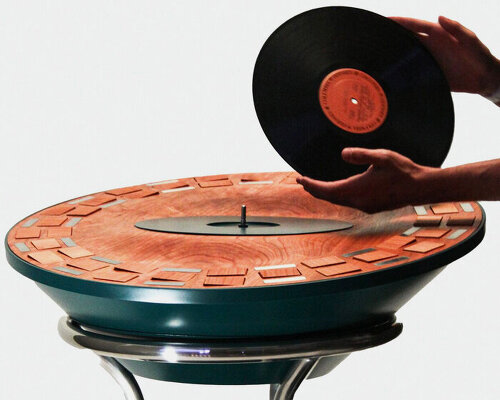lillian brown’s turntable translates sound into motion
Lillian Brown’s Orbit reimagines the record player as a performative object that makes music visible. What began as her senior thesis at the Savannah College of Art and Design (SCAD) evolved into a hybrid that turns listening into an active sensory experience, where rhythm becomes motion.
The design centers around a sculptural turntable topped with thirty-nine individual wooden tiles that flip and shift in real time as music plays. These movements, in sync with the beat, translate audio frequencies into a tactile visual field that unfolds in a clockwise motion, echoing the rotation of the record itself. Brown describes Orbit as a way to ‘make music visible,’ transforming familiar listening rituals into performances.
the wooden tiles are paired with stainless steel insets | images courtesy of Lillian Brown
wooden tiles of orbit dance to the rhythm
Fabricated through a meticulous process, Orbit combines CNC-milled cherry wood, thin stainless steel insets, and 3D printed components. Brown collaborated with machinist Jake Harding of Forsyth Metal Works to produce the cherry wood top, which underwent several complex CNC operations. The rich natural figure of the wooden surface contrasts with the steel inlays, while bent stainless steel legs recall mid-century modern record players.
Underneath its refined form lies a direct-drive motor and a hidden linear-tracking tonearm, an engineering approach inspired by Miniot’s Wheel. By inverting the record so it plays upside down, the industrial designer frees the kinetic tile system to occupy the center stage. Developed through a custom framework in Grasshopper, a parametric design tool, the tile system demonstrates how computational design can intersect with emotional experience. Over two months of concept exploration and another two months of fabrication resulted in this object, which stands one meter tall and is charged with potential energy. Orbit slows down the act of listening, asking the user to watch and feel the rhythm.
CNC-milled cherry wood, a 3D printed housing, and stainless steel legs come together
Orbit presents a sleek silhouette
echoing the elegance of vintage turntables
a custom parametric framework in Grasshopper was used to create the tile pattern
as the record plays, the wooden tiles flip and move in response to the music
the motion unfolds in a synchronized, clockwise rotation that echoes the record’s spin
bent metal legs nod to mid-century design
project info:
name: Orbit
designer: Lillian Brown
designboom has received this project from our DIY submissions feature, where we welcome our readers to submit their own work for publication. see more project submissions from our readers here.
edited by: thomai tsimpou | designboom
The post ‘orbit’ kinetic turntable translates sound into motion through flipping wooden tiles appeared first on designboom | architecture & design magazine.

